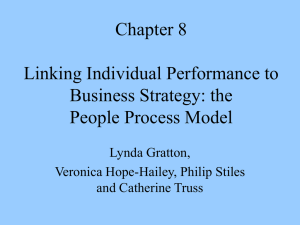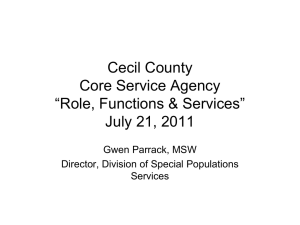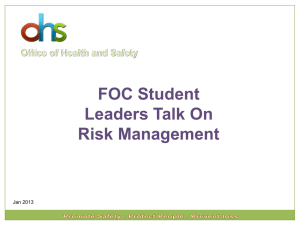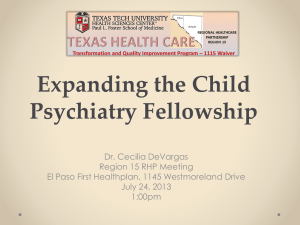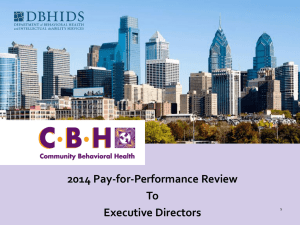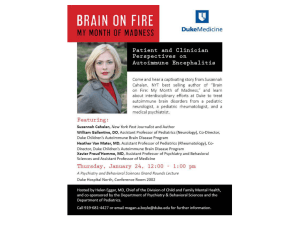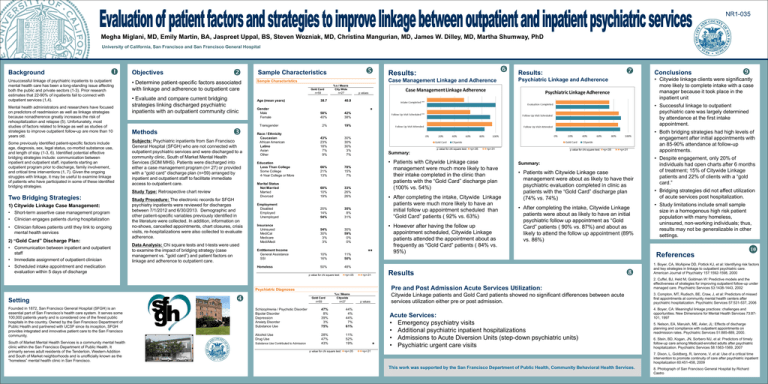
NR1-035
Megha Miglani, MD, Emily Martin, BA, Jaspreet Uppal, BS, Steven Wozniak, MD, Christina Mangurian, MD, James W. Dilley, MD, Martha Shumway, PhD
University of California, San Francisco and San Francisco General Hospital
Background
Unsuccessful linkage of psychiatric inpatients to outpatient
mental health care has been a long-standing issue affecting
both the public and private sectors (1-3). Prior research
estimates that 22-90% of inpatients fail to connect with
outpatient services (1,4).
Mental health administrators and researchers have focused
on predictors of readmission as well as linkage strategies
because nonadherence greatly increases the risk of
rehospitalization and relapse (5). Unfortunately, most
studies of factors related to linkage as well as studies of
strategies to improve outpatient follow-up are more than 10
years old.
Some previously identified patient-specific factors include
age, diagnosis, sex, legal status, co-morbid substance use,
and length of stay (1-3, 6). Identified potential effective
bridging strategies include: communication between
inpatient and outpatient staff, inpatients starting an
outpatient program prior to discharge, family involvement,
and critical time interventions (1, 7). Given the ongoing
struggles with linkage, it may be useful to examine linkage
of patients who have participated in some of these identified
bridging strategies.
Objectives
• Determine patient-specific factors associated
with linkage and adherence to outpatient care
• Evaluate and compare current bridging
strategies linking discharged psychiatric
inpatients with an outpatient community clinic
Methods
Subjects: Psychiatric inpatients from San Francisco
General Hospital (SFGH) who are not connected with
outpatient psychiatric services and were discharged to a
community clinic, South of Market Mental Health
Services (SOM MHS). Patients were discharged into
either a case management program (n= 27) or provided
with a “gold card” discharge plan (n=59) arranged by
inpatient and outpatient staff to facilitate immediate
access to outpatient care.
Study Type: Retrospective chart review
Two Bridging Strategies:
1) Citywide Linkage Case Management:
• Short-term assertive case management program
• Clinician engages patients during hospitalization
• Clinician follows patients until they link to ongoing
mental health services
2) “Gold Card” Discharge Plan:
• Communication between inpatient and outpatient
staff
• Immediate assignment of outpatient clinician
• Scheduled intake appointment and medication
evaluation within 5 days of discharge
Study Procedure: The electronic records for SFGH
psychiatry inpatients were reviewed for discharges
between 7/1/2012 and 6/30/2013. Demographic and
other patient-specific variables previously identified in
the literature were collected. In addition, information on
no-shows, cancelled appointments, chart closures, crisis
visits, re-hospitalizations were also collected to evaluate
adherence.
Data Analysis: Chi square tests and t-tests were used
to examine the impact of bridging strategy (case
management vs. "gold card”) and patient factors on
linkage and adherence to outpatient care.
Sample Characteristics
Case Management Linkage and Adherence
Sample Characteristics
Gold Card
n=59
Age (mean years)
Gender
Male
Female
Transgender
Race / Ethnicity
Caucasian
African American
Latino
Asian
Other
38.7
% s / Means
City Wide
n=27
42%
38%
2%
19%
43%
23%
18%
7%
9%
30%
30%
30%
3%
7%
66%
21%
13%
78%
15%
7%
Marital Status
Not Married
Married
Divorced
60%
10%
19%
33%
26%
26%
Employment
Disabled
Employed
Unemployed
20%
14%
54%
35%
8%
31%
Insurance
Uninsured
MediCal
Medicare
Medi/Medi
54%
30%
3%
3%
30%
59%
0%
0%
Entitlement Income
General Assistance
SSI
10%
16%
11%
50%
Homeless
50%
48%
p value for chi square test: =p<.05
p value for chi square test:=p<.05
Gold Card
n=59
% s / Means
Citywide
n=27
Founded in 1872, San Francisco General Hospital (SFGH) is an
essential part of San Francisco’s health care system. It serves some
100,000 patients yearly and is considered one of the finest public
hospitals in the country. Owned by the San Francisco Department of
Public Health and partnered with UCSF since its inception, SFGH
provides integrated and innovative patient care to the San Francisco
community.
Schizophrenia / Psychotic Disorder
Bipolar Disorder
Depression
Anxiety Disorder
Substance Use
47%
8%
39%
3%
75%
44%
4%
44%
7%
61%
Alcohol Use
Drug Use
South of Market Mental Health Services is a community mental health
clinic within the San Francisco Department of Public Health. It
primarily serves adult residents of the Tenderloin, Western Addition
and South of Market neighborhoods and is unofficially known as the
“homeless” mental health clinic in San Francisco.
Substance Use Contributed to Admission
28%
47%
43%
11%
52%
19%
p value for chi square test: =p<.05
=p<.01
p value for chi square test: =p<.05
Summary:
• Patients with Citywide Linkage case
management were much more likely to have
their intake completed in the clinic than
patients with the “Gold Card” discharge plan
(100% vs. 54%)
• After completing the intake, Citywide Linkage
patients were much more likely to have an
initial follow up appointment scheduled than
“Gold Card” patients ( 92% vs. 63%)
• However after having the follow up
appointment scheduled, Citywide Linkage
patients attended the appointment about as
frequently as “Gold Card” patients ( 84% vs.
95%)
=p<.01
Summary:
• Patients with Citywide Linkage case
management were about as likely to have their
psychiatric evaluation completed in clinic as
patients with the “Gold Card” discharge plan
(74% vs. 74%)
• After completing the intake, Citywide Linkage
patients were about as likely to have an initial
psychiatric follow up appointment as “Gold
Card” patients ( 90% vs. 87%) and about as
likely to attend the follow up appointment (89%
vs. 86%)
Results
=p<.01
p values
• Successful linkage to outpatient
psychiatric care was largely determined
by attendance at the first intake
appointment.
58%
40%
Conclusions
• Citywide linkage clients were significantly
more likely to complete intake with a case
manager because it took place in the
inpatient unit
Psychiatric Linkage and Adherence
p values
Psychiatric Diagnoses
Setting
Results:
40.9
Education
Less Than College
Some College
4-Year College or More
Results:
• Both bridging strategies had high levels of
engagement after initial appointments with
an 85-90% attendance at follow-up
appointments.
• Despite engagement, only 20% of
individuals had open charts after 6 months
of treatment; 15% of Citywide Linkage
patients and 22% of clients with a “gold
card.”
• Bridging strategies did not affect utilization
of acute services post hospitalization.
• Study limitations include small sample
size in a homogenous high risk patient
population with many homeless,
uninsured, non-working individuals; thus,
results may not be generalizable in other
settings.
References
10
1. Boyer, CA, McAlpine DD, Pottick KJ, et al: Identifying risk factors
and key strategies in linkage to outpatient psychiatric care.
American Journal of Psychiatry 157:1592-1598, 2000
Pre and Post Admission Acute Services Utilization:
2. Cuffel, BJ, Held M, Goldman W: Predictive models and the
effectiveness of strategies for improving outpatient follow-up under
managed care. Psychiatric Services 53:1438-1443, 2002
Citywide Linkage patients and Gold Card patients showed no significant differences between acute
services utilization either pre or post admission.
3. Compton, MT, Rudisch, BE, Craw, J, et al: Predictors of missed
first appointments at community mental health centers after
psychiatric hospitalization. Psychiatric Services 57:531-537, 2006
Acute Services:
• Emergency psychiatry visits
• Additional psychiatric inpatient hospitalizations
• Admissions to Acute Diversion Units (step-down psychiatric units)
• Psychiatric urgent care visits
=p<.01
4. Boyer, CA: Meaningful linkage practices: challenges and
opportunities. New Dimensions for Mental Health Services 73:87101, 1997
5. Nelson, EA, Maruish, ME, Axler, JL: Effects of discharge
planning and compliance with outpatient appointments on
readmission rates. Psychiatric Services 51:885-889, 2000.
6. Stein, BD, Kogan, JN, Sorbero MJ, et al: Predictors of timely
follow-up care among Medicaid-enrolled adults after psychiatric
hospitalization. Psychiatric Services 58:1563-1569, 2007
7. Dixon, L, Goldberg, R, Iannone, V, et al: Use of a critical time
intervention to promote continuity of care after psychiatric inpatient
hospitalization 60:451-458, 2009
This work was supported by the San Francisco Department of Public Health, Community Behavioral Health Services.
8. Photograph of San Francisco General Hospital by Richard
Castro


